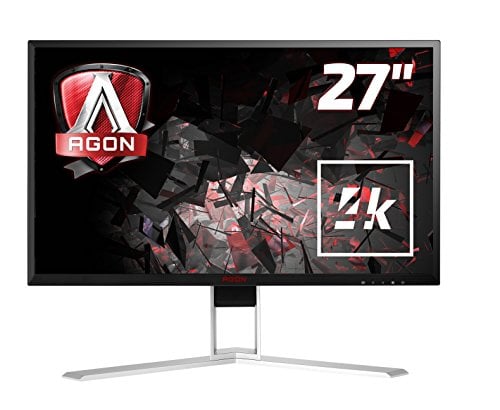AOC AGON AG271UG Review

AOC’s latest premium panel comes at a price
We live in an age when tablet computers with high-DPI IPS screens are handed out in boxes of Corn Flakes (other corn based cereals are available). Well, almost.
[sc name=”ad 2″]
Similarly, you’re nobody in the smartphone game without a decent high-DPI IPS panel at the very least. To be really competitive, you’re talking OLED technology.
Yet the one device that could both most benefit from and make the best use of such displays lags miles off the pace, wheezing along as other devices dip over the horizon.
Yes, we speak of the PC. That’s not to say the PC monitor market has been stagnant.
Far from it, what with the arrival of adaptive sync, HDR, and super-wide aspect ratios.
Resolutions and panel sizes are up, too.
But true high-DPI? Not so much.
At least, not at a price most of us can afford.
So, it’s hardly surprising to find that AOC’s latest premium panel, the AGON AG271UG. It’s a 27-inch model, with IPS tech, and a healthy 4K pixel grid. That makes for a relatively high 168 pixels per inch for a PC monitor. By the standards of phones and tablets, which generally don’t get out of bed for less than 250 ppi, it’s still pitiful.
Likewise, it’s hard to understand why this panel costs more than twice the price of a TN 4K monitor of the same size.
Remember also that AOC trades on value. A similar monitor from Asus or Acer would be even more expensive. If it sounds like we’re harshing on AOC, far from it. As this type of panel goes, the AG271UG has a lot going for it.
It sports lovely, vibrantyet-natural colors.
It delivers well in our test images, too, rendering white and black scales with little visible compression.
Super-smooth gradient rendering is on the menu, too.
Pixel response is subjectively nice and zippy, to boot, especially for an IPS panel. Even better, all this is achieved with none of that nasty inverse ghosting stuff that’s a consequence of aggressive pixel overdrive settings.
Black levels and contrast are good, though not quite a match for the best VA panels. There’s little evidence of IPS glow, either, which is welcome.
It must also be said that by the standards of PC monitors, the 3840×2160 pixel resolution makes for very sharp image quality and nice font rendering. What you don’t get is that super smoothness that comes with a DPI so high that individual pixels virtually disappear.
You also don’t get a truly high-quality stand and enclosure.
Superficially, it checks all the right boxes: There’s full adjust-ability, including height, swivel, rotate, and tilt, the bezel is thin, and the stand is made of metal.
But the design is dated, and the whole ensemble is awkward to assemble.
At this relatively high price, you’d expect a slick clip-in arrangement for attaching the stand to the chassis, not a quartet of cheapo screws. The external, rather than integrated, power supply is worth a demerit or two, as well.
Of course, high-DPI technology implemented on the PC remains a mixed bag, due to the way both Windows and the web handles it.
Driving really high resolutions in games is problematic, as well.
Likewise, the 4K resolution more or less dictates the AG271UG’s 60Hz refresh.
4K 120Hz panels are coming, but they will be even more expensive.
So, simply throwing more pixels at a screen like this isn’t a cure-all.
But when you can buy a 40-inch 4K TV, capable of 60Hz refresh, for half the price of this, never mind all those high-DPI portable devices for pennies, the value proposition seems marginal.
It’s a nice screen, this AOC, but like pretty much all of its direct competition, it feels overpriced for what you’re getting.
When you purchase through links on our site, I may earn an affiliate commission. Here’s how it works.
[Jeremy laird]
SPECIFICATIONS
panel Size 27 inches
native resolution 3840×2160
pixel Density 168 ppi
panel type IPS
Maximum refresh 60Hz
response 4ms
contrast 20m:1 (dynamic)
Display inputs DisplayPort 1.2, HDMI 1.4
connectivity 4x USB 3.0
VeSaMount 100 x 100mm
Warranty Three years







